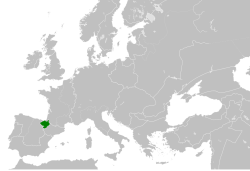
Back Reino de Navarra AN مملكة نبرة Arabic مملكة ناڤارا ARZ Reinu de Navarra AST Navarra krallığı Azerbaijani ناوار شاهلیغی AZB Каралеўства Навара Byelorussian Кралство Навара Bulgarian Regne de Navarra Catalan Navarrské království Czech
Kingdom of Navarre | |||||||||||||||||||||
|---|---|---|---|---|---|---|---|---|---|---|---|---|---|---|---|---|---|---|---|---|---|
| 824 (traditional)–1841 | |||||||||||||||||||||
 The Kingdom of Navarre in Europe, 1190 | |||||||||||||||||||||
| Capital | Pamplona (Basque: Iruña) 42°49′01″N 1°38′34″W / 42.81694°N 1.64278°W | ||||||||||||||||||||
| Common languages | |||||||||||||||||||||
| Religion | Majority religion:
Minority religions:
| ||||||||||||||||||||
| Government | Feudal monarchy | ||||||||||||||||||||
| Monarch | |||||||||||||||||||||
• 824–851/2 | Íñigo Arista (first) | ||||||||||||||||||||
• 1610–1620 | Louis II (last. French kingdom) | ||||||||||||||||||||
• 1830–1841 | Isabel II of Spain (last. Spanish kingdom) | ||||||||||||||||||||
| Historical era | Middle Ages | ||||||||||||||||||||
• Established | 824 | ||||||||||||||||||||
• Disestablished | 1841 | ||||||||||||||||||||
| Area | |||||||||||||||||||||
| 1300[6] | 10,000 km2 (3,900 sq mi) | ||||||||||||||||||||
| Population | |||||||||||||||||||||
• 1300[6] | 100,000 | ||||||||||||||||||||
| |||||||||||||||||||||
| Today part of | Spain France | ||||||||||||||||||||
The Kingdom of Navarre (/nəˈvɑːr/; Basque: Nafarroako Erresuma, Spanish: Reino de Navarra, French: Royaume de Navarre, Latin: Regnum Navarrae), originally the Kingdom of Pamplona (Basque: Iruñeko Erresuma), was a Basque kingdom that occupied lands on both sides of the western Pyrenees, with its northernmost areas originally reaching the Atlantic Ocean (Bay of Biscay), between present-day Spain and France.[7][8]
The medieval state took form around the city of Pamplona during the first centuries of the Iberian Reconquista. The kingdom had its origins in the conflict in the buffer region between the Carolingian Empire and the Umayyad Emirate of Córdoba that controlled most of the Iberian Peninsula. The city of Pamplona (Latin: Pompaelo; Basque: Iruña), had been the main city of the indigenous Vasconic population and was located in a predominantly Basque-speaking area.[9]
In an event traditionally dated to 824, Íñigo Arista was elected or declared ruler of the area around Pamplona in opposition to Frankish expansion into the region, originally as vassal to the Córdoba Emirate. This polity evolved into the Kingdom of Pamplona. A series of partitions and dynastic changes led to a diminution of its territory and to periods of rule by the kings of Aragon (1054–1134) and France (1285–1328).
In the 15th century, another dynastic dispute over control by the king of Aragon led to internal divisions and the eventual conquest of the southern part of the kingdom by Ferdinand II of Aragon in 1512 (permanently annexed in 1524). It was annexed by the Courts of Castile to the Crown of Castile in 1515 as a separate kingdom with its own Courts and judiciary until 1841.
The remaining northern part of the kingdom was once again joined with France by personal union in 1589 when King Henry III of Navarre inherited the French throne as Henry IV of France, and in 1620 it was merged into the Kingdom of France. The monarchs of this unified state took the title "King of France and Navarre" until its fall in the French Revolution, and again during the Bourbon Restoration from 1814 until 1830 (with a brief interregnum in 1815).
The ancient Kingdom of Navarre covered, at its greatest extent, approximately the modern-day Spanish autonomous communities of Navarre, Basque Country and La Rioja and the French territory of Lower Navarre in Pyrénées-Atlantiques.
- ^ a b c Amorrortu, Estibaliz. Basque Sociolinguistics: Language, Society, and Culture. University of Nevada Press, 2003, 14 note5.
- ^ Trask 1997, p. 427; Harvey, L. P. (1996). Muslims in Spain, 1500 to 1614. Chicago: Chicago University Press. pp. 124–125. ISBN 978-0-226-31964-3.
- ^ Jurio, Jimeno (1995). Historia de Pamplona y de sus Lenguas. Tafalla: Txalaparta. pp. 82, 138, 175–177. ISBN 84-8136-017-1.
- ^ Harvey, L. P. (1996). Muslims in Spain, 1500 to 1614. Chicago: Chicago University Press. p. 125. ISBN 978-0-226-31964-3.; Ciervide Martinena, Ricardo Javier (1980). "Toponimia navarra: historia y lengua". Fontes Linguae Vasconum (34): 90, 91, 102. Retrieved 2016-10-30.
- ^ Force, Pierre (2016). Wealth and Disaster: Atlantic Migrations from a Pyrenean Town in the Eighteenth and Nineteenth Centuries. Hopkins Press - Johns Hopkins University. p. 15. ISBN 9781421421292.
- ^ a b Reilly, Bernard F. (1993). The Medieval Spains. Cambridge University Press. p. 139. ISBN 9780521397414.
The new kingdom of Castile had roughly tripled in size to some 335,000 square kilometers by 1300 but, at the same time, its population had increased by the same factor, from one to three millions [...] Little Navarre with its area of only 10,000 square kilometers and some 100,000 people still had a Muslim minority of about 10,000.
- ^ Middleton, John (2015-06-01). World Monarchies and Dynasties. Routledge. ISBN 978-1-317-45158-7.; NA, NA (2016-04-30). Medieval Queenship. Springer. ISBN 978-1-137-08859-8.; Collins, Roger (2012-05-07). Caliphs and Kings: Spain, 796-1031. John Wiley & Sons. ISBN 978-0-631-18184-2.; Trask 1997.
- ^ Cite error: The named reference
britannicawas invoked but never defined (see the help page). - ^ Trask 1997, p. 427; Collins, R. 1989, p. 159.

